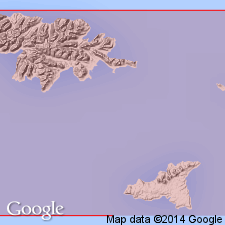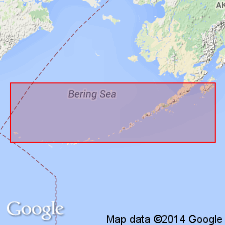
- Usage in publication:
-
- Krugloi Formation*
- Modifications:
-
- Named
- Dominant lithology:
-
- Sandstone
- Conglomerate
- Siltstone
- Argillite
- AAPG geologic province:
-
- Aleutian Islands province
- Alaska Southwestern region
Summary:
Named for exposures in mountain peaks from Krugloi Point westward to Peak I, Agattu Island, Near Islands, Aleutian Islands, AK. Generalized section on northern Agattu Island is about 7400 ft thick. Unit covers eastern one-fifth of island from north to south shore. Consists primarily of conglomerate, sandstone, mudstone, siltstone, argillite, and chert with minor lava flows and pyroclastic deposits. Gradationally overlies basement rocks of pillow lava flows, breccia, tuff, tuffaceous sandstone. Basement rocks and Krugloi are intruded by diabase and gabbro dikes. Age given as Mesozoic or Tertiary on basis of similar lithologies with rocks on Attu.
Source: GNU records (USGS DDS-6; Menlo GNULEX).

- Usage in publication:
-
- Krugloi Formation*
- Modifications:
-
- Age modified
- Biostratigraphic dating
- Geochronologic dating
- AAPG geologic province:
-
- Aleutian Islands province
- Alaska Southwestern region
Summary:
Age is middle or late Eocene based on nannoplankton fossils and stratigraphic relations and 34 Ma K-Ar radiometric age from quartz diorite dike cutting the unit. Age is older than 34 Ma.
Source: GNU records (USGS DDS-6; Menlo GNULEX).
For more information, please contact Nancy Stamm, Geologic Names Committee Secretary.
Asterisk (*) indicates published by U.S. Geological Survey authors.
"No current usage" (†) implies that a name has been abandoned or has fallen into disuse. Former usage and, if known, replacement name given in parentheses ( ).
Slash (/) indicates name conflicts with nomenclatural guidelines (CSN, 1933; ACSN, 1961, 1970; NACSN, 1983, 2005, 2021). May be explained within brackets ([ ]).

